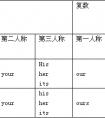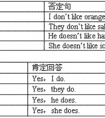用所给动词的适当形式填空。1. I'm sorry(say)that there’s nothing(eat).2. This afternoon the biggest football match of this year (be)on TV.3. They told us t-九年级英语
①It is going to rain. 要下雨了。
②We are going to have a meeting today. 今天我们开会。
二.go, come,start,move,sail,leave,arrive,stay,live,fly,等可用进行时态表示按计划即将发生的动作(行进式动词)。
例如:I'm leaving for Beijing.
三.“be to+动词原形”表示按计划要发生的事或征求对方意见。例如:
①Are we to go on with this work?我们继续干吗?
②The boy is to go to school tomorrow.这个男孩明天要去上学。
四.“be about to+动词原形”表示即将发生的动作,意为:很快,马上。后面一般不跟时间状语。例如:
We are about to leave.我们马上就走。
五.某些词,如come, go, leave, arrive, start, get, stay ,live,fly等的一般现在时也可表示将来。
①The meeting starts at five o'clock.会议五点开始。
②He gets off at the next stop.他下一站下车。
六。“be due to"构成的谓语,意味“定于…”也可表示将来时。
主将从现是指在时间状语从句和条件状语从句和让步状语从句中,如果主句是一般将来时,从句用一般现在时替代一般将来时。
主将从现常见的有以下四种情况:
一、时间状语从句的主句是一般将来时,那么从句常常用一般现在时。
如: When I grow up, I’ll be a nurse and look after patients.我长大后要当一名护士,照顾病人。
二、如果主句是祈使句,那么从句通常要用一般现在时
如:Don’t laugh at me when I make a mistake.我犯错误的时候不要笑话我。
三、如果主句是含有情态动词的一般现在时,根据需要从句多用一般现在时
如:You should be quiet when you are in the reading room.在阅览室时应保持安静。
四、 如果if的条件状语从句遇到变换间接和直接时 , 祈使句应用not to....
如:She said not to close the window
常见的时间状语从句的连词有:as soon as,when,while ,as,until等
主将从现说的是在含有时间状语从句和条件状语从句的主从复合句中,如果主句的时态是一般将来时,那么从句要用一般现在时。例如:
I will tell him about it when he comes.
If it is fine tomorrow, we will go outing.
如果主句的时态是过去将来时,那么从句要用一般过去时。例如:
He said that he would have another try if he had the chance.
I knew he could help me if he was free the next day.
主要标志有:if 、unless 、until、 when 、as soon as
考点名称:过去完成时
- 过去完成时:
是把时间推移到过去某一时间之前,与现在不发生联系,由"had+-ed分词"构成。 基本结构:
主语+had+过去分词vpp.(done)
①肯定句:主语+had+过去分词+其他.
②否定句:主语+had+not+过去分词+其他.
③一般疑问句:Had+主语+过去分词+其他?
肯定回答:Yes,主语+had
否定回答:No,主语+hadn't
④特殊疑问句:特殊疑问词或词组+一般疑问句(Had+主语+过去分词+其他)?
⑤被动语态:主语+had(hadn't)+been+过去分词+其他过去完成时基本用法:
(1)表示在过去某一时刻或动作以前完成了的动作,即“过去的过去”。
可以用by, before等介词短语或一个时间状语从句来表示,也可以用一个表示过去的动作来表示,还可能通过上下文来表示。
By nine o’clock last night, we had got 200 pictures from the spaceship.到昨晚9点钟,我们已经收到200 张飞船发来的图片。
(2)表示由过去的某一时刻开始,一直延续到过去另一时间的动作或状态,常和for, since构成的时间状语连用。
He said he had worked in that factory since 1949.他说自从1949年以来他就在那家工厂工作。
(3)叙述过去发生的事情,在已叙述了过去发生的事情后,反过来追述或补述以前发生的动作时,常使用过去完成时。
I didn’t know a thing about the verbs, for I had not studied my lesson.我对动词一无所知,因为我没有好好学习功课。
(4)在含有定语从句的主从复合句中,如果叙述的是过去的事,先发生的动作常用过去完成时
She found the key that she had lost.她丢失的钥匙找到了。
(5)过去完成时常常用在宾语从句(或间接引语)中,这时从句中的动作发生在主句表示的过去的动作之前。
I thought I had sent the letter a week before. 我认为我一星期前就把信寄出去了。
(6)在包含有when, until等连词的复合句中,如果主句谓语动词和从句谓语动词所表示的过去动作不是同时发生的,
那么先发生的动作通常用过去完成时表示。
She didn’t go to bed until she had finished he work.她直到把工作做完之后才睡觉。
注意:如果两个动作紧接着发生,则常常不用过去完成时,特别是在包含before和after的复合句中,因为这时从句的动作和主句的动作发生的先后顺序已经非常明确,这时可以用一般过去时代替过去完成时。
(7)动词think, want, hope, mean, plan, intend等用过去完成时来表示过去未曾实现的想法,希望,打算或意图等。
We had hoped to be able to come and see you .我们本来希望能来看看你。
(8)过去完成时还可用在hardly…when…, no sooner…than…, It was the first (second, etc) time (that)…等固定句型中。
It was the third time that he had been out of work that year.这是他那一年第三次失业了。- 过去完成时与现在完成时的区别:
现在完成时表示的动作发生在过去,但侧重对现在产生的结果或造成的影响,与现在有关,其结构为“助动词 have (has) + 过去分词”;
过去完成时则是一个相对的时态,它所表示的动作不仅发生在过去,更强调“过去的过去”,只有和过去某时或某动作相比较时,才用到它。
比较:I have learned 1000 English words so far.到目前为止我已经学会了 1000 个英语单词。
I had learned 1000 English words till then.到那时为止我已经学会了 1000 个英语单词。
— I'm sorry to keep you waiting. 对不起,让你久等了。
— Oh, not at all. I have been here only a few minutes.没什么,我只等了几分钟。(“等”的动作从过去某一时间点持续到现在)
过去完成时与一般过去时的区别:
虽然这两种时态都表示过去发生的动作或存在的状态,但在使用时应注意以下几点:
1. 时间状语不同:过去完成时在时间上强调“过去的过去”;而一般过去时只强调过去某一特定的时间。
比较:They had arrived at the station by ten yesterday.
They arrived at the station at ten yesterday.
2. 在没有明确的过去时间状语作标志时,谓语动词动作发生的时间先后须依据上下文来判断:先发生的用过去完成时,后发生的则用一般过去时。
She was very happy. Her whole family were pleased with her, too. She had just won the first in the composition competition.
3. 当两个或两个以上接连发生的动作用 and 或 but 连接时,按时间顺序,只需用一般过去时来代替过去完成时;另外,在 before , after , as soon as 引导的从句中,由于这些连词本身已经表示出时间的先后,因此也可以用过去时来代替过去完成时。
He entered the room, turned on the light and read an evening paper. 语法判定:
一、由时间状语来判定
一般说来,各种时态都有特定的时间状语。与过去完成时连用的时间状语有:
(1) by + 过去的时间点。如:
I had finished reading the novel by nine o'clock last night.
(2) by the end of + 过去的时间点。如:
We had learned over two thousand English words by the end of last term.
(3) before + 过去的时间点。如:
They had planted six hundred trees before last Wednesday.
二、由“过去的过去”来判定
过去完成时表示“过去的过去”,是指过去某一动作之前已经发生或完成的动作,即动作有先后关系,动作在前的用过去完成时,在后的用一般过去时。这种用法常出现在:
(1)宾语从句中
当宾语从句的主句为一般过去时,且从句的动作先于主句的动作时,从句要用过去完成时。在told, said, knew, heard, thought等动词后的宾语从句。如:
She said that she had seen the film before.
(2)状语从句中
在时间、条件、原因、方式等状语从句中,主、从句的动作发生有先后关系,动作在前的,要用过去完成时,动作在后的要用一般过去时。如:
After he had finished his homework, he went to bed.
注意: before, after 引导的时间状语从句中,由于 before 和 after 本身已表达了动作的先后关系,若主、从句表示的动作紧密相连,则主、从句都用一般过去时。如:
After he closed the door, he left the classroom.
(3)表示意向的动词,如hope, wish, expect, think, intend, mean, suppose等,用过去完成时表示"原本…,未能…"
We had hoped that you would come, but you didn't.
- 最新内容
- 相关内容
- 网友推荐
- 图文推荐
| [家长教育] 孩子为什么会和父母感情疏离? (2019-07-14) |
| [教师分享] 给远方姐姐的一封信 (2018-11-07) |
| [教师分享] 伸缩门 (2018-11-07) |
| [教师分享] 回家乡 (2018-11-07) |
| [教师分享] 是风味也是人间 (2018-11-07) |
| [教师分享] 一句格言的启示 (2018-11-07) |
| [教师分享] 无规矩不成方圆 (2018-11-07) |
| [教师分享] 第十届全国教育名家论坛有感(二) (2018-11-07) |
| [教师分享] 贪玩的小狗 (2018-11-07) |
| [教师分享] 未命名文章 (2018-11-07) |


![Sunday is my birthday. I would like _____ a birthday party, would you _____to my party? [ ]A. have; come B. to have; to come C. have; to come D. to have-七年级英语](http://www.00-edu.com/d/file/ks/4/2/budingshi/2020-01-08/smalla85122db0c71d7fb6ae58187be7f1fd11578430330.png)

![Why areyou here? You are supposed ______ in the classroom now. [ ] A. to studyB. to be studiedC. studying D. to be studying -九年级英语](http://www.00-edu.com/d/file/ks/4/2/budingshi/2020-01-08/small6dee02daa62cac1c71853ac804ab4fbd1578422460.png)
![She is very poor. Little food _____ and no room _____! [ ]A. to eat, to live B. to eat, to live in C. eating, living -八年级英语](http://www.00-edu.com/d/file/ks/4/2/budingshi/2020-01-09/small17b77c2697a3ef8f1461d0d14b016ee51578585185.png)


